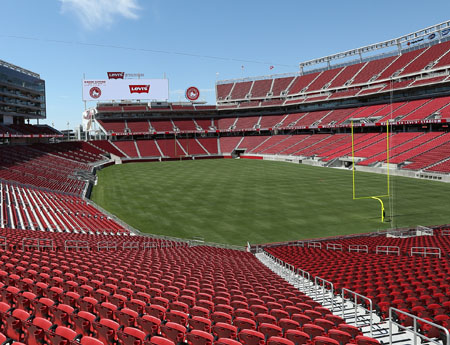Big-Gain Tech Takes the Field for 49ers

Broadcasters offering lavish HD productions of high-profile sports events gets lots of press. Making less noise but no less of an impression, professional teams have been upping their own game in recent years, adding a host of cutting edge TV and digital technologies to new venues such as the San Francisco 49ers’ Levi’s Stadium, which opened July 17.
“The NFL knows that people can sit at home with a big beautiful flatscreen TV, an iPad, a well-stocked refrigerator and no waiting lines for the bathroom,” says Robert Alberino Jr., 49ers VP and executive producer. “I believe there is no better way to see a game than at the stadium…but teams have to compete against the couch….We have to think about what we can do to make this the most kickbutt game anyone could watch.”
That focus is also important for broadcast equipment vendors faced with a relatively sluggish TV market. Here, Sony has been particularly active. Coming off work on new stadiums for the Dallas Cowboys, Philadelphia Eagles, L.A. Dodgers and other top sports teams, Sony was chosen as the general contractor to design and install five major aspects of the new venue: the control room; the ITPV systems; the gigantic LED displays; the TVs and screens around the stadium; and security cameras.
Score One for Technology
The resulting Levi’s Stadium, which at press time was scheduled to host its first 49ers game Aug. 17, is arguably the most advanced attempt to use new technologies from the TV and digital world to reinvent a football stadium.
For video production, Alberino notes that they have Sony’s top line production switcher, the MVS-7000, three Evertz Dreamcatcher replay systems, Chyron graphics, high-end Sony cameras, including two 4K F55s, and other systems that are able to handle feeds from 16 to 20 cameras. Besides Sony gear, other vendors include Click Effects, Grass Valley, Canon, Fujinon, Telemetrics, Clearcom, RGB Networks and Elemental Technologies. “For the in-stadium show we really have an infrastructure that is broadcast quality,” Alberino says.
This video infrastructure will feed content to over 2,000 screens (including Ultra HD TVs in all the suites) and two massive LED screens from Daktronics at each end of the stadium, which will also display data and social media feeds. When combined with 40GB of connectivity to power 1,000 wireless access points— way more than any other U.S. stadium—fans will be able to view a wide array of content on either the stadium screens or on the teams’ new second-screen apps—when they’re not busy looking at Colin Kaepernick and the team in action on the field itself.
Broadcasting & Cable Newsletter
The smarter way to stay on top of broadcasting and cable industry. Sign up below
Thanks to that connectivity, Alberino says he’s had no trouble posting pictures or viewing video replays even when the stadium held 42,000 people for its soft launch in July. In the future, the technology will also open up many possibilities for delivering feeds that are personalized for individual users or targeted to specific parts of the stadium.
Chris Sullivan, national sales manager for sports venues at Sony Electronics calls this a multiyear project, with a number of developments, such as the full deployment of the IPTV system, the launch of 4K video feeds and enhancements to the second-screen experiences still in the works.
“What you see in year one will be fantastic but it will keep growing from there,” Sullivan says. “We’re very excited to be working with the 49ers right in the middle of Silicon Valley on some incredible experiences.”
Levi’s Good Fit: Ultra HD
San Francisco 49ers executives believe the new Levi’s Stadium is the first to widely embrace Ultra HD, with the deployment of two Sony F55 cameras, large screen 4K TVs in every suite and a control room and infrastructure capable of handling 4K feeds.
Robert Alberino Jr., VP and executive producer for the 49ers, says they won’t be working in 4K on opening day but that they “expect to get there fairly quickly.”
Alberino also stresses that his team of about a dozen people work on all platforms and that they will use their highend HD and 4K cameras for video both for the big LED screens and the Web. “It all starts with really great-looking video,” he says.
